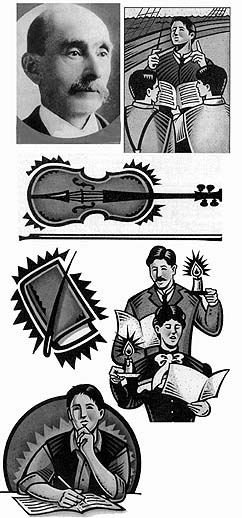“George Careless, Music Missionary,” Friend, Sept. 1996, 46
Heroes and Heroines:
George Careless, Music Missionary
Based on The Mormon Tabernacle Choir by Charles Jeffrey Calman, pages 39–44.
Hymns invite the Spirit of the Lord, create a feeling of reverence, … and provide a way for us to offer praise to the Lord (Hymns, First Presidency Preface).
As early Saints reached Utah, President Brigham Young issued calls to some of them to serve missions to many nations of the world, to others to colonize areas outside the Salt Lake Valley. George Careless was prepared to accept any call he received.
“Brother George,” President Young said, “I have a mission for you. … I want you to take the Tabernacle Choir … and lay a foundation for good music in Utah.” Brother Careless accepted the call.
Born in London on September 24, 1839, George displayed musical talent early in life. His father, a woodcarver, berated his son for “wasting time” with music and told him to learn a trade. George went to work in a shoemaking company, but his heart wasn’t in it. The plant foreman, a music lover who collected violins, loaned him one of them, and George soon learned to play it.
When he was ten years old, he was offered a place in a London choir school, where boys earned their academic and musical education by singing in a church or cathedral. It was a wonderful opportunity, but George turned it down. He had recently joined The Church of Jesus Christ of Latter-day Saints and was eager to participate fully in it.
George’s father never accepted his devotion to music and told him to either give it up or leave the family. So when he was thirteen, George left home.
Later, the shoe factory foreman loaned George the money to attend the Royal Academy of Music. After graduating in three years rather than the usual four, he was hired as a member of an orchestra that gave concerts in the Crystal Palace, England’s showplace for the arts. With his first earnings, he repaid the foreman.
At the same time, George worked to improve the musical activities of the Church in England. He directed a London Conference choir, earning it such a high reputation that it was invited to perform at several of London’s leading concert halls.
His career was progressing so well that Elder William C. Staines encouraged him to move to Utah before he became so famous that it would be almost impossible to leave those who went to hear him. Six weeks later, George sailed for America. On his ship, the Hudson, he led a choir composed of Saints who were immigrating to Utah. He arrived in New York City on July 19, 1864. From there he suffered illness and hunger much of the rest of the way.
Arriving in the Salt Lake Valley, George was given the depressing news that the few professional musicians already there were unable to make a living with their music. Even so, he was determined to teach music even if he starved. By the end of the next month, he had twenty-four paying pupils. The going rate for a series of lessons in the Salt Lake Valley was a hundred pounds of flour.
When President Young called him to his musical mission, George replied, “I will do the best I can with the material I can get.”
The prophet responded, “You will have to make that.”
Organizing a choir in the rough conditions of frontier living took determination and grit as well as talent. At his first rehearsal of the choir, only forty members were present. The Tabernacle, still under construction, had no heating or lighting. Choir members held a candle in one hand, their music in the other.
On October 8, 1873, the Salt Lake Tabernacle Choir joined with choirs from fourteen surrounding communities to perform at General Conference. Some of the choirs had to travel several days to reach Salt Lake City.
When Brigham Young died in 1877, George assembled a 220-member choir to perform a hymn he composed for the funeral.
After serving eleven years as director of the Tabernacle Choir, George resigned his post in 1880. His mission was to continue, though, when President John Taylor asked him to head a committee to write music for all the hymns to be included in The Latter-day Saints’ Psalmody, published in 1889. The Psalmody contained 330 hymns, three-fourths of them set to music by Mormon composers. One of Brother Careless’s compositions is the well-known sacrament hymn “He Died! The Great Redeemer Died.”
George Careless fulfilled his mission to lay a foundation for good music, not just in Utah but in the whole Church.

Illustrated by Scott Greer